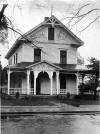The Hiller Family
Written by Ann Berghaus and Edited by Carolyn Harris. ©2002 (Photographs are property of the Wilmington Historical Commission)
Table of Contents
- Education, Marriages, and Dr. Hiller’s Elixir
- A House in Wilmington
- Active in the Community
- Sarcophagi
- Death of Dr. Hiller
- France’s Casket Is Finished
- Dr. Hiller and France Renew Their Vows
- France’s Death
- The Caskets Are Buried
Education, Marriages, and Dr. Hiller’s Elixir
[_BACK TO TOP_]
France Pharao, not Francis, it is believed was born in 1845 in either London, England or Demerrar, South America! She graduated from London Medical School and married Thomas Plant by all accounts a very handsome sea captain. He died shortly after the marriage. France met Dr. Henry Hiller in London. He was born in Mannheim Germany in 1845, and had received his medical degree from the University of Goettingen. They fell in love and were married in 1868 in London. They honeymooned on Cape Cod in Massachusetts, and decided the opportunities were better in America so they stayed.
For a short time they lived in Malden and Melrose. Dr. Henry Hiller had offices on Tremont Row in Boston. There he and eight other doctors who worked for him made approximately $75,000 a year on Dr. Hiller’s Elixir. The Doctor’s Elixir was a cure all…. it (supposedly) could cure everything from cancer, to a hang nail… It could also revitalize and restore a person’s energy. It was most likely comprised of whiskey and water, but it sold well, and many customers had faith in it. The Elixir made the Hiller’s a very wealthy family. But money isn’t everything ….. As Mrs. Hiller once said to a reporter… Everything we touched turned to gold in our hands. We were as happy as could be save for one thing. Children were born to us, but they did not live. Though we both were vigorous, our little ones pined away and died in early life; so of the 23 darlings I have borne, 14 of whom were twins, not one is alive today to give joy to my heart and add sunshine to my home. It was God’s will. Let his will be done.”
A House in Wilmington
[_BACK TO TOP_]
Perhaps it was the clean, crisp air and the sparkling lake; perhaps the convenience of the train rumbling through the tiny town. Whatever it was, it lured the Hillers to Wilmington. They built a lovely house on the town’s Main Street. It was the most beautiful of it’s day. It had fourteen rooms, and a lovely porch which ran along three sides of the house. They included beautiful stained glass windows, and front steps of granite with the Hiller name cared on it. The Hiller’s loved wood carvings and included many intricate wood designed throughout the house including a hand-carved mahogany alligator with his mouth wide open at the bottom of the banister of the main stairs….France Hiller had a particular affection for alligators.
The Hiller’s were well known throughout Wilmington. Every evening they strolled down Main Street arm and arm. She was well known for wearing the finest of silk dresses and having diamond rings on each finger including her thumb.
In the community they purchased large tracts of land. They took great pride in the community and when they saw or heard of a house that had fallen into disrepair they offered to pay for the cost of rehabilitating the house, if the owner wouldn’t accept the money, quite often they purchased the house, made the repairs and gave it back to the original owner.
Active in the Community
[_BACK TO TOP_]
Both were quite active in community affairs: In 1875 Henry signed the Constitution for Wilmington’s Farmer’s and Mechanics Club. France Hiller participated in the many club activities including annual fairs in which she entered oil paintings and crochet work for competition. She won prizes for her fruits, vegetables and honey. And she was a keynote speaker at several club dinners. Dr. Henry Hiller also served on the auditing committee with Charles Swain, Thomas Eames and Deacon Sheldon. When Charles W. Swain began the Wilmington Public Library, Dr. Henry Hiller served as a library trustee in 1878.
Mrs. Hiller developed a seven acre cranberry bog which started operation in 1880. She had a large house built near the bog which was used for the cranberry business. She paid her workers a decent wage of 54 cents a bushel. By all accounts her cranberries were some of the best in the area.
Dr. Henry Hiller built a large building on Church Street to house a laboratory and to store his collection of rare stuffed animals (the type of stuffed animal that at one time was alive!) He had hoped to establish a museum in this building which was to resemble a Castle.
Dr. Henry Hiller was also a member of the Cemetery Commission. The issue of death was of major concern to the Hillers. Both dreaded the thought of their bodies decaying in the ground after their death. They both agreed that upon their death, they must be placed in caskets above the ground for all to see. The Hillers decided to have their caskets hand crafted. They hired James MacGregor who started on the first casket in 1883. MacGregor quoted them a cost of $40.00 a day. It would he said take himself and four assistants seven years to make the two caskets.
Sarcophagi
[_BACK TO TOP_]
The caskets were described as a sarcophagus with an inner casket. The outside casket was supported by eight heavy brass lion’s paws. They were 17 inches high, cost $100.00 apiece, and weighted 475 pounds. When the steel hammock was hung inside the inner box, and the lion’s paws were put under the whole affair, the caskets stood five feet from the floor and weighed a little over 2,000 pounds. It was said to have cost $30,000. The cover of the casket had two ivy vines running around the edge, meeting in center where there was a skull carved in the wood. Out of the eye socket in the skull was a creeping lizard. On the ends and sides of the casket were carved: angels, cupids and dragons by the dozen. There were bats flying over serpents and a big owl holding a tiny field mouse in his talons. All this was carved in four inch thick mahogany. The inside box was a metal hammock suspended from the four corners of the inner chamber, and on the cover of this box were gold and silver plates engraved with portraits of the doctor and his wife and their 23 children. In addition Mrs. Hiller planned a mausoleum 40 feet square and 40 feet high, with plate glass windows behind a bronze grating so that visitors could come and look at the costly coffins and fancy carvings. “To watchmen,” said Mrs. Hiller “I’ll be on guard day and night and there will be lights burning as long as the world lasts.”
Death of Dr. Hiller
[_BACK TO TOP_]
Sadly, Dr. Henry Hiller died as a result of a carriage accident on November 7, 1888 at age 43. Dr. Daniel Buzzell was the attending physician. The caskets weren’t ready!! Henry was placed in a vault in Winchester then moved to a brick temporary tomb in Wilmington until his casket was completed. France Hiller was deeply shocked and depressed by her husband’s sudden death.
She slowly began to take an active interest in the cemetery itself. She took her husbands’ place on the Cemetery Commission. She sought to improve and enlarge Wildwood Cemetery. She held fertilizer parties. Wagonloads of fertilizer and good soil was hauled into the cemetery and spread. She planted trees along the pathways. She planted grass over the tomb that was to be Henry’s while she waited for the completion of the casket.
Finally on September 4, 1889 a funeral was held. She organized a torchlight parade. Mourners and bands were brought to Wilmington by train. Everyone who had helped beautify the cemetery was invited to attend. The parade headed by the band started from the Hiller Home. Every horse and buggy in town was there; most with flaming torches to light the way. After Henry’s entombment, the procession went to Wilmington’s Town Hall draped with black bunting and exhibiting a portrait of Dr. Hiller. Dr. Henry Hiller was eulogized as a pillar of Wilmington society.
France’s Casket Is Finished
[_BACK TO TOP_]
For weeks after the funeral, the trolley which went up and down Church Street made a special stop at Wildwood Cemetery so the curious could walk over and see Dr. Hiller’s vault. Each morning France Hiller was driven to the cemetery to say good morning to Henry and place fresh flowers on his grave. When France’s casket was finished she had it delivered to Wilmington and placed in the Cranberry House. She would get all dressed up in her white satin burial robe with over five hundred yards of lace which was imported from France at a cost of $20,000. She would wear her favorite diamonds and other jewels. Then she would have her coachman drive her to the Cranberry House. There her attendants were waiting to place her on a satin hammock and lower her into her coffin. There was a large mirror on the ceiling. She would look at herself in preparation for her own funeral. At times she would invite those closest to her to …have a sneak preview of events to come…..!!!! She was so taken by the craftsmanship of her casket that she put it on exhibition in Boston’s Horticultural Hall. …. Unfortunately few attended the exhibit!!!
Dr. Hiller and France Renew Their Vows
[_BACK TO TOP_]
Five years after the death of Dr. Henry Hiller, friends and relatives were startled when they received an invitation printed with gold ink that read as follows: “You are cordially invited to be present at the renewal of marriage vows of France B. Hiller and Henry Hiller, at their residence at Easter Sunday, April 2, 1893 The new Henry Hiller was in fact the devoted coachman Peter Surette. Peter had come from a fine family; he was loyal and devoted to France. He approached her and asked for her hand in marriage. In Mrs. Hiller’s own words…” I was thunderstruck at first, but the subject attracted my attention; and I said,” Why not. He is honest, loyal, obedient, and loving. “I made inquiries and Fr. Ryan spoke to Peter …. I was assured that he came from a very good family, and was a very good man. Peter did not love my money but me.” France Hiller did have a few requests of Peter. She asked that he change his name to Henry Hiller (this was done by a special act of the Legislature), and he was to sign a pre-nuptial agreement. It was a somewhat May – December marriage. He was 23 and France was approximately 48.
Their wedding was the talk of Wilmington. She wore a elegant white silk dress and diamond necklace, tiara, and diamond rings on each finger. Peter (Henry) was handsome in his black evening suit with a white embroidered silk vest, pearl colored silk gloves and white satin puff tie. Their carriage was pulled by four white horses down to St. Thomas church. The bridal party followed in 11 carriages pulled also by four milk-white steeds. Reporters were sent out from Boston to cover the wedding. Headlines read: “No Sweller Wedding Than Mrs. Dr. Hillers”. However she had sprained her ankle earlier in the morning and was in extreme pain during most of the day. When she arrived home, she was carried up to her room. She was attended by Dr. Buzzell. Down stairs, the wedding reception continued as though nothing had happened….An elaborate collation was served, and there was music and merrymaking until late into the evening … but the bride was not there…. ” By all accounts they seemed to be happy in their relationship.
France’s Death
[_BACK TO TOP_]
France Hiller’s health began to fail … and she even built a house for Henry so that he could entertain his friends without bothering her as she became worse. It appears that Mrs. Hiller was in constant pain. And was given medication accordingly. She died of an apparent liver ailment on May 18, 1900. The day had finally come … The Funeral of the Century in Wilmington. Reporters were sent from Boston to cover the story. One report Stated “thousands crammed the trolleys and steam cars, hundreds of others blocked the side roads with carriages and bicycles.” Everyone wanted to get a glimpse of the casket which had been in waiting now for 12 years. The funeral car, covered in black velvet was pulled by four black horses draped with black netting. It was too high to go under the trolley wires, so carpenters hastily cut down 14 inches. The flower landau and other hacks were also drawn by black horses. Henry rode in the first of eight carriages in the procession. Reporters’ cameras clicked as the casket rolled down Middlesex Ave. The police had to push back the crowd waiting outside St. Thomas Church so they could get the casket inside for the funeral. There was over 500 people in the church alone. After the funeral mass the casket was placed back on the funeral car and the procession continued to Wildwood where the casket was placed on rollers and pushed inside.
The Caskets Are Buried
[_BACK TO TOP_]
At last Mrs. Hiller was laid to rest in the style of her choice. However…..don’t go looking for the tomb today…. At the Town Meeting of 1890 it was voted: “That the town offer Mrs. Dr. Hiller any lot or any number of lots not now sold, (in Wildwood provided, that she will build her mausoleum in this Town.” Contrary to Town Meeting, in early June, 1935, it was decided that the 10 foot high tomb at the entrance to Wildwood Cemetery was an eyesore. So it was decided to level the ground and put the caskets in the ground. Not at all what Dr. and Mrs. Hiller had wanted. The workmen discovered the caskets in excellent condition and none of the carvings had decayed. Both caskets were lowered from the tomb into the ground, and there they are today…..marked only by two large granite planters and brass name plates.
Henry Hiller the second remained in Wilmington until his death almost forty years later on.












